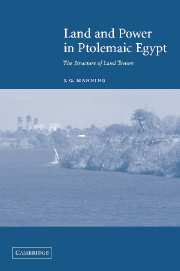Book contents
- Frontmatter
- Contents
- List of maps, figures and tables
- Preface
- Abbreviations
- Units of measure
- Maps
- Part I ISSUES AND HISTORICAL BACKGROUND
- Part II REGIONAL CASE STUDIES OF LAND TENURE
- Part III INTERPRETATION
- Appendix 1 Translation of the Edfu donation text
- Appendix 2 Ptolemaic demotic land transfers from Upper Egypt
- Appendix 3 Translation of P. Amh. gr. 49
- List of references
- Index of sources
- General index
Appendix 1 - Translation of the Edfu donation text
Published online by Cambridge University Press: 22 September 2009
- Frontmatter
- Contents
- List of maps, figures and tables
- Preface
- Abbreviations
- Units of measure
- Maps
- Part I ISSUES AND HISTORICAL BACKGROUND
- Part II REGIONAL CASE STUDIES OF LAND TENURE
- Part III INTERPRETATION
- Appendix 1 Translation of the Edfu donation text
- Appendix 2 Ptolemaic demotic land transfers from Upper Egypt
- Appendix 3 Translation of P. Amh. gr. 49
- List of references
- Index of sources
- General index
Summary
The text is recorded on the outside of the retaining wall of the temple of Horus at Edfu. It consists of 65 columns of text in 8 panels, each introduced by an offering scene, lower register (above base) of the external face of the eastern enclosure wall, starting from the northern extremity (PM 6.167.337–344 third register, plan p. 130).
Graphic writing of fractions 60 and 80 only used in the donations suggests that the intermediate manuscript was written in the hieratic script. The rest of the text was certainly composed in demotic. Only P. Wilbour allows comparison. This is not a cadastre, but, rather, a tax list of cultivated land where each parcel is defined by its topographic situation, status of ownership, the name of the cultivator, the area of plot and tax assessment.
This translation is heavily indebted to the work of Meeks. Numbers in parentheses refer to the hieroglyphic text of Meeks 1972. Note ar. = aroura.
PRINCIPAL TEXT (4*3)
Protocol
The perfect god, son of the lord of Hermopolis, divine seed of the lord of largesse who reckons the amount of the measured fields of Egypt, filling the healthy eye of that which is necessary, satisfying the gods and goddesses by means of their offerings, the lord of gardens, the king of Upper and Lower Egypt, heir of the gods Euergetai, select of Ptah, who acts justly, living image of Amun-Re.
- Type
- Chapter
- Information
- Land and Power in Ptolemaic EgyptThe Structure of Land Tenure, pp. 243 - 266Publisher: Cambridge University PressPrint publication year: 2003



